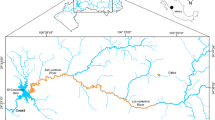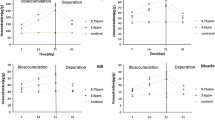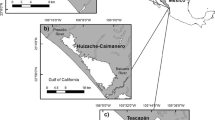Abstract
Oreochromis niloticus was subjected to sub-lethal Cd and Zn concentrations for 14 days in order to evaluate their accumulation in the gills, liver, and muscle. Following that, the fish were placed to uncontaminated water for 7 days to allow the metals to be removed from the tissues. The gills had the highest bio-concentration factor for Cd and Zn. The gills showed the highest Cd accumulation rate, and the muscle showed the lowest. The muscle had the highest Cd depuration rate, while the liver had the lowest. The liver exhibited the highest Zn accumulation rate, while the gills and muscle had nearly similar values. Zn depuration rates were very consistent across all tissues.

Similar content being viewed by others
References
Abu Hilal AH, Ismail NS (2008) Heavy metals in eleven common species of fish from the Gulf of Aqaba, Red Sea. Jordan J Biol Sci 1:13–18
Adesiyan IM, Bisi-Johnson M, Aladesanmi OT, Okoh AI, Ogunfowokan AO (2018) Concentrations and human health risk of heavy metals in rivers in Southwest Nigeria. J Health Pollut 8:1–14. https://doi.org/10.5696/2156-9614-8.19.180907
Amiard JC, Amiard-Triquet C, Barka S, Pellerin J, Rainbow PS (2006) Metallothioneins in aquatic invertebrates: their role in metal detoxification and their use as biomarkers. Aquat Toxicol 76:160–202. https://doi.org/10.1016/j.aquatox.2005.08.015
Bergman HL, Dorward-King EJ (1997) Reassessment of Metals Criteria for Aquatic Life Protection. SETAC Press, Pensacola
Cinier CdeC, Petit-Ramel M, Faure R, Garin D, Bouvet Y (1999) Kinetics of cadmium accumulation and elimination in carp Cyprinus carpio tissues. Comp Biochem Physiol C 122:345–352. https://doi.org/10.1016/S0742-8413(98)10132-9
Dhaneesh KV, Gopi M, Ganeshamurthy R, Kumar TTA, Balasubramanian T (2012) Bio-accumulation of metals on reef associated organisms of Lakshadweep Archipelago. Food Chem 131:985–991
Eisler R (2010) Compendium of trace metals and marine biota. Vertebrates Elsevier, Amsterdam
El-Moselhy KM, Othmanb AI, Abd El-Azema H, El-Metwally MEA (2014) Bioaccumulation of heavy metals in some tissues of fish in the Red Sea, Egypt. Egypt J Basic Appl Sci 1:97–105. https://doi.org/10.1016/j.ejbas.2014.06.001
Elnabris KJ, Muzyed SK, El-Ashgar NM (2013) Heavy metal concentrations in some commercially important fishes and their contribution to heavy metals exposure in Palestinian people of Gaza Strip (Palestine). J Assoc Arab Univ Basic Appl Sci 13:44–51
Fu Z, Wu F, Chen L, Xu B, Feng C, Bai Y, Liao H, Suna S, Giesya JP, Guo W (2016) Copper and zinc, but not other priority toxic metals, pose risks to native aquatic species in a large urban lake in Eastern China. Environ Pollut 219:1069–1076. https://doi.org/10.1016/j.envpol.2016.09.007
Gorur FK, Keser R, Akcay N, Dizman S (2012) Radioactivity and heavy metal concentrations of some commercial fish species consumed in the Black Sea Region of Turkey. Chemosphere 87:356–361. https://doi.org/10.1016/j.chemosphere.2011.12.022
Handayani KS, Soegianto A, Lignot J-H (2020) Change of osmoregulatory and hematological parameters in tilapia (Oreochromis niloticus) after exposure to sublethal mercury concentrations. Emerg Contam 6:337–344. https://doi.org/10.1016/j.emcon.2020.08.006
Handy RD (1992a) The assessment of episodic metal pollution. II. The effects of cadmium and copper enriched diets on tissue contaminant analysis in rainbow trout (Oncorhynchus mykiss). Arch Environ Contam Toxicol 22:82–87. https://doi.org/10.1007/BF00213305
Handy RD (1992b) The assessment of episodic metal pollution. I. Uses and limitations of tissue contaminant analysis in rainbow trout (Oncorhynchus mykiss) after short waterborne exposure to cadmium or copper. Arch Environ Contam Toxicol 22:74–81. https://doi.org/10.1007/BF00213304
Hardy RW, Sullivan CV, Koziol AM (1987) Absorption, body distribution, and excretion of dietary zinc by rainbow trout (Salmo gairdneri). Fish Physiol Biochem 3:133–143. https://doi.org/10.1007/BF02180415
Kalay M, Canli M (2000) Elimination of essential (Cu, Zn) and nonessential (Cd, Pb) metals from tissue of a freshwater fish Tilapia zillii following an uptake protocol. Tukr J Zool 24:429–436
Kargın F, Çoğun HY (1999) Metal interactions during accumulation and elimination of zinc and cadmium in tissues of the freshwater fish Tilapia nilotica. Bull Environ Contam Toxicol 63:511–519. https://doi.org/10.1007/s001289901010
Kim SG, Jee JH, Kang JC (2004) Cadmium accumulation and elimination in tissues of juvenile olive flounder, Paralichthys olivaceus after sub-chronic cadmium exposure. Environ Pollut 127:117–123. https://doi.org/10.1016/s0269-7491(03)00254-9
Larsson A, Haux C, Sjobeck M-U (1985) Fish physiology and metal pollution: results and experiences from laboratory and field studies. Ecotoxicol Environ Saf 9:250–281. https://doi.org/10.1016/0147-6513(85)90045-4
Ma’rifah F, Saputri MR, Soegianto A, Irawan B, Putranto TWC (2019) The change of metallothionein and oxidative response in gills of the Oreochromis niloticus after exposure to copper. Animals 9:353. https://doi.org/10.3390/ani9060353
McGeer JC, Szebedinszky C, McDonald DG, Wood CM (2000) Effects of chronic sub-lethal exposure to waterborne Cu, Cd, or Zn in rainbow trout: 1. Iono-regulatory disturbance and metabolic costs. Aquat Toxicol 50:233–245. https://doi.org/10.1016/s0166-445x(99)00105-8
Newman MC (2015) Fundamentals of ecotoxicology, the science of pollution. CRC Press, Boca Raton
Nordberg GF, Fowler BA, Nordberg M, Friberg LT (2007) Handbook on the toxicology of metals. Elsevier, London
Putranto TWC, Dewi S, Affandi M, Soegianto A (2020) Effects of Cd, Zn and Cd + Zn combination on osmoregulation of tilapia (Oreochromis niloticus). Asian J Wat Environ Pollut 17:49–53. https://doi.org/10.3233/AJW200035
Qadir A, Malik RN (2011) Heavy metals in eight edible fish species from two polluted tributaries (Aik and Palkhu) of the River Chenab, Pakistan. Biol Trace Elem Res 143:1524–1540. https://doi.org/10.1007/s12011-011-9011-3
Shaffi SA, Manohar YR, Nandan MJ (2001) Influence of protective agents on metal induced respiratory distress in Labeorohita (Ham). Bull Environ Contam Toxicol 66:611–616. https://doi.org/10.1007/s001280052
Suresh A, Sivaramakrishna B, Radhakrishnaiah K (1993) Patterns of cadmium accumulation in the organs of fry and fingerlings of freshwater fish Cyprinus carpio following cadmium exposure. Chemosphere 26:945–953
Taylor D (1983) The significance of the accumulation of cadmium by aquatic organisms. Ecotoxicol Environ Saf 7:33–42. https://doi.org/10.1016/0147-6513(83)90046-5
Wekell JC, Shearer KD, Houle CR (1983) High zinc supplementation of rainbow trout diets. Prog Fish-Cult 45:144–147
Yang H-N, Chen H-C (1996) Uptake and elimination of cadmium by Japanese eel, Anguilla japonica, at various temperatures. Bull Environ Contam Toxicol 56:670–676. https://doi.org/10.1007/s001289900098
Zhao S, Feng C, Quan W, Chen X, Niu J, Shen Z (2012) Role of living environments in the accumulation characteristics of heavy metals in fishes and crabs in the Yangtze River Estuary, China. Mar Pollut Bull 64:1163–1171. https://doi.org/10.1016/j.marpolbul.2012.03.023
Acknowledgements
Ministry of Research and Technology of Indonesia provided funding for this study under contract number 787/UN3.14/PT/2020. There are no conflicts of interest declared by the authors.
Author information
Authors and Affiliations
Corresponding author
Additional information
Publisher’s Note
Springer Nature remains neutral with regard to jurisdictional claims in published maps and institutional affiliations.
Rights and permissions
About this article
Cite this article
Soegianto, A., Widyanita, A., Affandi, M. et al. Cadmium and zinc accumulation and depuration in tilapia (Oreochromis niloticus) tissues following sub-lethal exposure. Bull Environ Contam Toxicol 109, 464–469 (2022). https://doi.org/10.1007/s00128-022-03504-8
Received:
Accepted:
Published:
Issue Date:
DOI: https://doi.org/10.1007/s00128-022-03504-8




